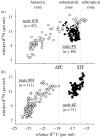Whisker isotopic signature depicts migration patterns and multi-year intra- and inter-individual foraging strategies in fur seals
- PMID: 19793740
- PMCID: PMC2828010
- DOI: 10.1098/rsbl.2009.0552
Whisker isotopic signature depicts migration patterns and multi-year intra- and inter-individual foraging strategies in fur seals
Abstract
The movement and dietary history of individuals can be studied using stable isotope records in archival keratinous tissues. Here, we present a chronology of temporally fine-scale data on the trophic niche of otariid seals by measuring the isotopic signature of serially sampled whiskers. Whiskers of male Antarctic fur seals breeding at the Crozet Islands showed synchronous and regular oscillations in both their delta(13)C and delta(15)N values that are likely to represent their annual migrations over the long term (mean 4.8 years). At the population level, male Antarctic fur seals showed substantial variation in both delta(13)C and delta(15)N values, occupying nearly all the 'isotopic space' created by the diversity of potential oceanic habitats (from high Antarctica to the subtropics) and prey (from Antarctic krill to subantarctic and subtropical mesopelagic fishes). At the individual level, whisker isotopic signatures depict a large diversity of foraging strategies. Some seals remained in either subantarctic or Antarctic waters, while the migratory cycle of most animals encompassed a wide latitudinal gradient where they fed on different prey. The isotopic signature of whiskers, therefore, revealed new multi-year foraging strategies of male Antarctic fur seals and is a powerful tool for investigating the ecological niche during cryptic stages of mammals' life.
Figures


References
-
- Bearhop S., Adams C. E., Waldron S., Fuller R. A., MacLeod H.2004Determining trophic niche width: a novel approach using stable isotope analysis. J. Anim. Ecol. 73, 1007–1012 (doi:10.1111/j.0021-8790.2004.00861.x) - DOI
-
- Beauplet G., Dubroca L., Guinet C., Cherel Y., Dabin W., Gagne C., Hindell M.2004Foraging ecology of subantarctic fur seals Arctocephalus tropicalis breeding on Amsterdam Island: seasonal changes in relation to maternal characteristics and pup growth. Mar. Ecol. Prog. Ser. 273, 211–225 (doi:10.3354/meps273211) - DOI
-
- Best P. B., Schell D. M.1996Stable isotopes in southern right whale (Eubalaena australis) baleen as indicators of seasonal movements, feeding and growth. Mar. Biol. 124, 483–494 (doi:10.1007/BF00351030) - DOI
-
- Bolnick D. I., Svanback R., Fordyce J. A., Yang L. H., Davis J. M., Hulsey C. D., Forister M. L.2003The ecology of individuals: incidence and implications of individual specialization. Am. Nat. 161, 1–28 (doi:10.1086/343878) - DOI - PubMed
-
- Cerling T. E., Wittemyer G., Ehleringer J. R., Remien C. H., Douglas-Hamilton I.2009History of animals using isotope records (HAIR): a 6-year dietary history of one family of African elephants. Proc. Natl Acad. Sci. 106, 8093–8100 (doi:10.1073/pnas.0902192106) - DOI - PMC - PubMed
Publication types
MeSH terms
Substances
LinkOut - more resources
Full Text Sources
